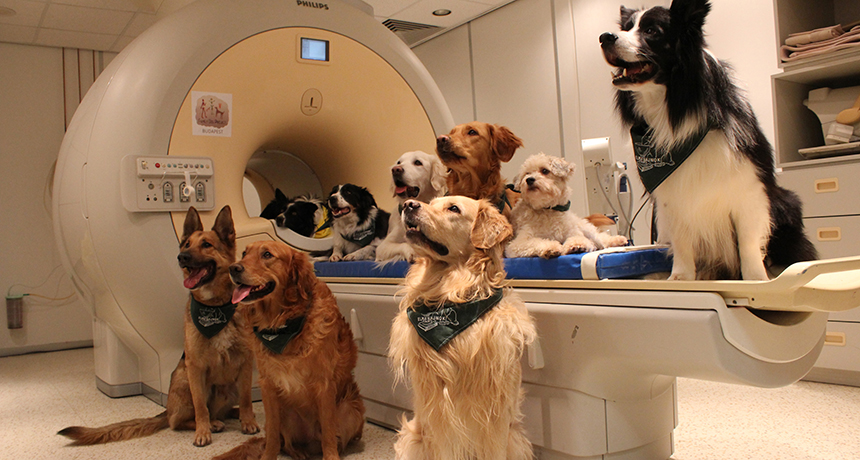Dog brains divide language tasks much like humans do

Editor’s note: When reporting results from the functional MRI scans of dogs’ brains, left and right were accidentally reversed in all images, the researchers report in a correction posted April 7 in Science. While dogs and most humans use different hemispheres of the brain to process meaning and intonation — instead of the same hemispheres, as was suggested — lead author Attila Andics says the more important finding still stands: Dogs’ brains process different aspects of human speech in different hemispheres.
Dogs process speech much like people do, a new study finds. Meaningful words like “good boy” activate the left side of a dog’s brain regardless of tone of voice, while a region on the right side of the brain responds to intonation, scientists report in the Sept. 2 Science.
Similarly, humans process the meanings of words in the left hemisphere of the brain, and interpret intonation in the right hemisphere. That lets people sort out words that convey meaning from random sounds that don’t. But it has been unclear whether language abilities were a prerequisite for that division of brain labor, says neuroscientist Attila Andics of Eötvös Loránd University in Budapest.
Dogs make ideal test subjects for understanding speech processing because of their close connection to humans. “Humans use words towards dogs in their everyday, normal communication, and dogs pay attention to this speech in a way that cats and hamsters don’t,” says Andics. “When we want to understand how an animal processes speech, it’s important that speech be relevant.”
Andics and his colleagues trained dogs to lie still for functional MRI scans, which reveal when and where the brain is responding to certain cues. Then the scientists played the dogs recordings of a trainer saying either meaningful praise words like “good boy,” or neutral words like “however,” either in an enthusiastic tone of voice or a neutral one.
The dogs showed increased activity in the left sides of their brains in response to the meaningful words, but not the neutral ones. An area on the right side of the brain reacted to the intonation of those words, separating out enthusiasm from indifference.
When the dogs heard praising words in an enthusiastic tone of voice, neural circuits associated with reward became more active. The dogs had the same neurological response to an excited “Good dog!” as they might to being petted or receiving a tasty treat. Praise words or enthusiastic intonation alone didn’t have the same effect.
Humans stand out from other animals in their ability to use language — that is, to manipulate sequences of sounds to convey different meanings. But the new findings suggest that the ability to hear these arbitrary sequences of sound and link them to meaning isn’t a uniquely human ability.
“I love these results, as they point to how well domestication has shaped dogs to use and track the very same cues that we use to make sense of what other people are saying,” says Laurie Santos, a cognitive psychologist at Yale University.
While domestication made dogs more attentive to human speech, humans have been close companions with dogs for only 30,000 years. That’s too quickly for a trait like lateralized speech processing to evolve, Andics thinks. He suspects that some older underlying neural mechanism for processing meaningful sounds is present in other animals, too.
It’s just hard to test in other species, he says — in part because cats don’t take as kindly to being put inside MRI scanners and asked to hold still.